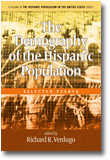
The Demography of the Hispanic Population
Selected Essays
Edited by:
Richard R. Verdugo, UAB - Centre for Demographic Studies, Barcelona, Spain
A volume in the series: The Hispanic Population in the United States. Editor(s): Richard R. Verdugo, UAB - Centre for Demographic Studies, Barcelona, Spain.
Published 2012
The Hispanic population has dramatically grown since the middle of the 20th Century. Demographers predict that by the year 2050, one in three Americans will of Hispanic origin. But the Hispanic population is not a homogeneous group; it varies by race and ethnicity, culture, economic status, education, and other important factors.
The purpose of the present volume is to provide information on selected topics regarding the growth, distribution, and size of the Hispanic population. The volume brings together an eclectic set of six research papers. The first four examine traditional demographic topics: population growth, mortality, and immigration. The last two address topics that are not often examined among Hispanics: Hispanic Baby Boomers, and an interesting study on self identification among Hispanics using vital events data and census data.
CONTENTS
Introduction, Richard R. Verdugo. 1 Hispanics, Immigrants, and the Growth of the U.S. Population: 1850–2007, Richard R. Verdugo. 2 Contemporary Migration and the Hispanic Population in the United States, Karen A. Woodrow-Lafield. 3 The Latino Paradox, Rogelio Sáenz and Trinidad Morales. 4 Mortality Among the U.S. Hispanic Population, Robert A. Hummer and Juanita J. Chinn. 5 Disappearing Hispanics? The Case of Los Angeles County, California: 1990–2000, Matt Kaneshiro, Amanda Martinez, and David A. Swanson. 6 Latino Baby Boomers: New Elders for a Diverse America, Fernando Torres-Gil, Zachary Gasoummis, and Kathleen Wilber.
-
Paperback978-1-61735-680-3
Web price: $45.04 (Reg. 52.99)
-
Hardcover978-1-61735-681-0
Web price: $80.74 (Reg. 94.99)
- eBook978-1-61735-682-7

- SOC006000 - SOCIAL SCIENCE: Demography
- HIS036000 - HISTORY: UNITED STATES: General
- SOC044000 - SOCIAL SCIENCE: ETHNIC STUDIES: Hispanic American Studies
-
 Hispanics in the US Labor Market
Selected Research
Hispanics in the US Labor Market
Selected Research
-
 The Demographic Crisis in Europe
Selected Essays
The Demographic Crisis in Europe
Selected Essays
-
 The Economic Status of the Hispanic Population
Selected Essays
The Economic Status of the Hispanic Population
Selected Essays
-
 The Education of the Hispanic Population
Selected Essays
The Education of the Hispanic Population
Selected Essays
-
 The National Council of Teachers of English and Cold War Education Policies
The National Council of Teachers of English and Cold War Education Policies
-
 The Spanish Language in America
A Case of Social Stratification
The Spanish Language in America
A Case of Social Stratification
-
 The Yellow Rose
Racial Stratification in a Mexican American Community
The Yellow Rose
Racial Stratification in a Mexican American Community

